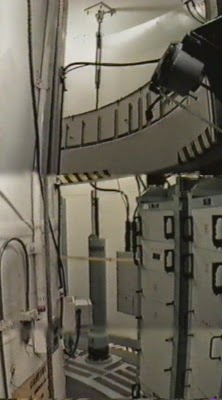 |
| Exterior view of a Minuteman missile silo |
This is the first in a series of the "History of Bates County" articles. Over the next few days we'll be covering the legacy of being one of the few counties in the United States that was actively involved in the Cold War by hosting Minuteman missiles and their control facilities.
You remember seeing them around the county- a driveway leading to a chain link enclosed area that included a sign reminding you that entering the area could have deadly consequences, per the U.S. Air Force.
Alas, you were looking at a Minuteman Missile Silo in it's purest form.
About 20 of the silos were scattered around the county under the command of two Launch Control Facilities (LCF), one located about six miles west of Passaic, and the other a few miles south of the Hudson school. The actual silos were scattered in an area that stretched from the northwest part of the county to the southeastern corner.
We often wondered what secrets were buried in the confines of the heavily secured area, only knowing that a missile capable of reaching Russia was hiding within. Thanks to declassification of documents, we now know.
In early 1960's numbers, each silo came at a cost of about $400,000. That's not including the 1.8 million dollar Minuteman missile, complete with nuclear warhead tucked inside. The Minuteman was a serious piece of hardware- about 60 feet long weighing 65,000 pounds and able to reach a top speed of 15,000 mph. Thus could be delivered anywhere in the world "In 30 minutes or less. Guaranteed" as promised by those working within the LCF's.
Occasionally we'd see trucks and workers at a silo, possibly doing maintenance work. A few times you might have even witnessed the changing out of a missile without fully realizing it. Those working at a silo did it in the most covert way with heavy security in mind.
 |
| Ground level access hatch (note guard) |
So what was actually underground at a Minuteman silo? First lets go through the steps of full entry (the entire process took about two hours):
At the gate, personnel would get on the Missile Net Radio, calling agencies at the LCF to let them know they arrived. Verification of authorization came from two different entities which could take 15 minutes. No entry through the gate was allowed until fully authorized. Any mistake in the entire process would be followed with a response team that would hold them at gunpoint until their presence was verified.
 |
| 'B plug' door |
Once inside the fenced area, a ground level access hatch would be opened, which was no quick task. The door, weighing about a ton would need to be 'jacked' open after several security pins were removed. This alone took up to 30 minutes.
 |
| B plug door lowered, allowing access to the silo |
 |
| Missile tube is on the left; guidance system and security equipment racks on the right |
About ten feet below the ground level hatch was another secured door, shown at right, known as the 'B plug'. Opening the 'B plug' was quite time consuming- two combinations had to be entered, pins removed, then wait. And wait. Eventually the 'B plug' hatch would begin lowering itself, allowing full access to the inner workings of the silo.
A large steel tube housed the missile. Another tube surrounded that tube which housed a plethora of equipment including miles of wire, lithium batteries, lead acid batteries, the guidance and control computer, security system, a diesel generator, air conditioning and much more. All of which was mounted on a floating 'shock absorber' system.
 |
| Cut away view of the silo |
1 : Missile Guidance Control System Cooling System
2 : Security System Drawer and Missile Power Supply 3 : Signal Data and Computer Control System
4 : Medium Frequency Radio System
5 : Pneumatic Shock Isolators
6 : MF Radio Low-pass Filter System
7 : AGE Power Supplies
8 : Air Conditioning System
9 : AC/DC Motor-Generator
10 : B-Plug (shown fully lowered)
11 : motorized screwjack for B-Plug
12 : LER #2 access ladder
13 : Electrical Surge Arrestor (ESA) room
14 : Launcher Closure Actuator System
15 : Emergency Power Batteries
16 : Signal/Power Distribution Box (D-Box)
 |
| Brains of the operation-the launch and guidance computer located deep in the missile silo |
Next in our series, we'll detail the Launch Control Facility and what actions would be taken if an actual call to launch was initiated.






